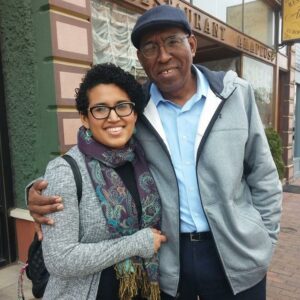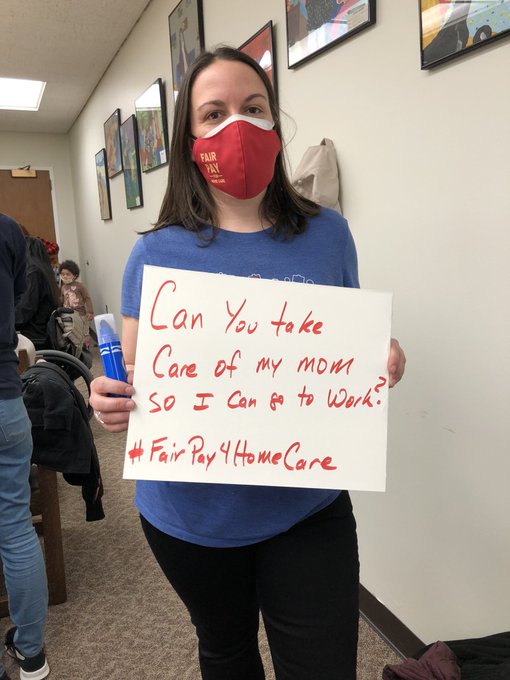
November is National Family Caregivers Month which recognizes over 65.7 million people who assist a loved one with personal care, skilled nursing tasks, and care management sometimes around the clock.
Family Caregivers are partners, spouses, grandparents, parents, and children of all ages who provide support to a loved one with essential daily tasks. Twenty-four percent of them report caring for more than one person. Some adult children are balancing care for their own children and parents – what is often called “sandwich” caregiving.
As our aging population increases, the struggles of family caregivers are becoming more and more apparent. Hand in Hand collected some of their stories during the 2022 midterm elections and through our ongoing Honor Domestic Work project.
“I am deeply thankful for my dad, a Black immigrant engineer from Peru who moved to the United States to provide me with opportunities he never had available to him. For years he has tended to me, even bringing me homemade lunch daily through the pandemic, because I have Lupus and other chronic illnesses that cause fatigue and pain.” – Veralucia Mendoza from Sylvania, OH
“At one point, I was caring for my dying mom, a two year old and a 7 year old. If not for the support of my partner and an incredibly progressive work environment, I would have been unable to keep these balls in the air.” — Erika McNichol from Ambler, PA
“Some folks refer to the period I’m in as the ‘sandwich years’ because I’m caring for my children and my parents (and myself when I get the time). When my mother fell ill it was so challenging to find support to supplement what we were able to do as young parents. Turnover was high, and when her memory began to fail we could not rely on help outside of what we could provide ourselves. It was ‘easier’ and more affordable for me to abandon child care for my children and health care costs for my mother and leave my job to do those things myself – which was not in my career plan. I am fortunate that I was able to do that while having a working spouse, but this is not an option for so many.” —Alexa Bosse from Philadelphia, PA
Unpaid and Undervalued
Caregiving and contributing to the wellness of a loved one is valuable and powerful work, but family caregivers are unpaid and receive no benefits for their labor. The economic value of unpaid caregiving services in 2013 was $470 billion, which was “more than the value of paid home care and total Medicaid spending in the same year.”
“I rely on unpaid care from my parents to be able to fully participate in my community.”
— Jenn Wolff from Waverly, IA
The financial cost to caregivers is high. 2 in 10 family caregivers give up full-time paid employment to provide care and spend on average $5500 per year in out-of-pocket expenses. Caregivers find it challenging to maintain full-time paid employment and lose $324,000 in wages and benefits over the course of their lives.
“I was a family caregiver and finding options that were both safe and affordable or finding support that wasn’t understaffed made everything harder in an already trying time of caring for a loved one with Dementia.”
—Heather Shafer from Monterey, CA
Caregivers carry a heavy burden for their families. They are more likely to suffer from depression and other chronic conditions. However, they also find joy and fulfillment in caring for their loved ones. Family caregivers want to provide care, but it shouldn’t be done at their own expense and with so little support.
“I am a parent of 2 children. I am a business owner and a homeowner. I have a disabled mother. Issues of affordable housing and affordable health care are critical to a caring society. Yet who has the true power to change these things? Not one person or one group. It must be society as a whole.”
— Leah Bruder from Hampton, VA
Connecting Family Caregiving with Domestic Worker Organizing
At Hand in Hand, we understand there is a direct connection between family caregivers and domestic workers, both of whose labor in private homes is exploited, goes unrecognized, and devalued. There is very little public policy support for family caregivers who often work multiple jobs or leave the labor market to care for their family members. Similarly, there are few labor protections for domestic workers. A focus on a market-based economy, rooted in racism and sexism, has attempted to erase this work that benefits all of us.

In many instances, family caregivers and domestic workers are working in teams. Some family caregivers, who can afford support or qualify for publicly funded support, hire home care or child care to knit together care for their loved ones. As a team one may be driving the family member to a doctor’s appointment, while the other is handling paperwork. The teams balance all the needs together. Family caregivers and domestic workers absorb the inadequacies of our care systems with little credit and no safety net.
As we look to the future of care in this country, we must be thinking about how to support family caregivers as part of the care economy— solutions like paying family caregivers, expanding access to home care subsidies, and making care jobs good jobs so there are enough workers to fill the growing demand for caregiving.
